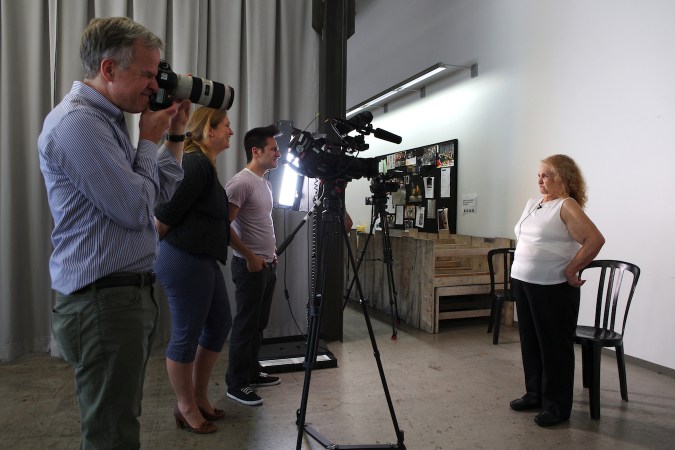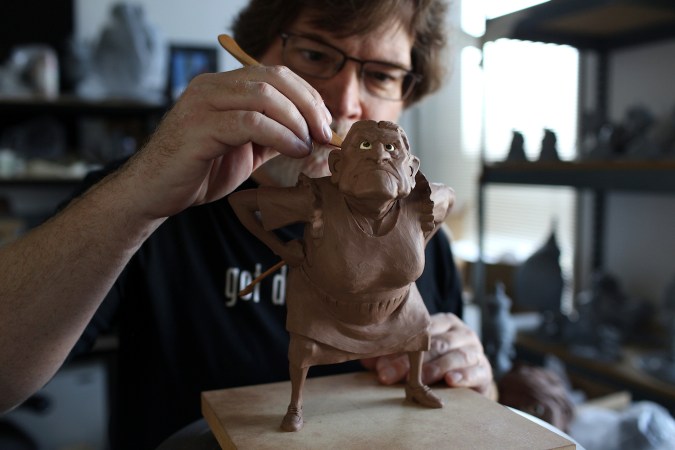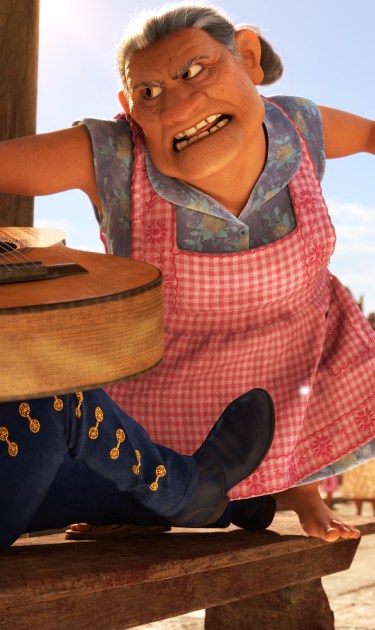At 88 years old, Pueblito Guzmán is a devoted mother of 10 and grandmother of many who was not afraid to use the feared chancla (sandal) when her children misbehaved. “I used the chancla, a stick, and everything. I had 10 kids! Imagine that! I threatened them with the chancla, soy muy amenazadora,” she told Remezcla in a phone interview. She spoke from her home, located in Northern California, not too far away from Pixar Animation Studios where she had her first encounter with moviemaking.
Pueblito, who was born in Querétaro but moved to Mexico City as a young girl, served as the model for many of the facial expressions and physical movements of the Abuelita character in Lee Unkrich and Adrian Molina’s Coco. The Mexico-set animated feature about a young boy named Miguel who travels to the Land of the Dead during the Día de Muertos holiday is the studio’s latest box office hit. In this world steeped in the afterlife, he meets deceased relatives and tries to undo his family’s long-held ban on music. Abuelita, Miguel’s grandma, is the perfect combination of feisty and loving, just like Pueblito who, fittingly, lent her expressiveness to the character’s vast emotional range.
RELATED: This Is What Latino Film Critics Are Saying About Pixar’s Coco
The two women have a lot in common. Both Pueblito and Abuelita (voiced by Renée Victor) are fans of using a chancla as a fear-inducing tool of discipline. Early on in the movie, we see one of the clearest examples of Pueblito’s contributions to the character’s appearance. In the scene, Miguel is shining a mariachi’s shoes when the musician offers the young boy a chance to play his guitar. Out of nowhere, Abuelita appears angrily yelling Miguel’s name. She’s furious at the mariachi, as evidenced by her scowl and furrowed brow. As Abuelita draws her chancla high, we see her arm jiggle and, in a close up, the wrinkly details on her hand and neck as she smacks the mariachi on the head with her shoe. A moment later, she is lovingly kissing Miguel. Pueblito inspired that swift roller coaster of emotions and the corresponding physical gestures.
Nick Rosario, as Coco’s Directing Animator, was in charge of overseeing the consistency of the animation throughout the production. He’s also married to Pueblito’s granddaughter and had long been fascinated by her ability to go from laughter to anger in a matter of minutes. “I’d always felt that she was really interesting and when I came on to Coco, I had seen the design of the character of Abuelita, and all the storyboard reels, and I felt that she was very similar in character. When we were building the actual model, I was kind of taking references from my grandma-in-law at a party.”
Nick’s own relationship with Mexican grandmothers goes back to his childhood in Bell Gardens, a mostly Latino city in Southern California. As one of the few white kids in the area, he frequently interacted with his Mexican friends’ families. His stepfather is also half-Puerto Rican and half-Mexican, so his proximity to Latino culture started very early on.
When Pixar’s team needed more specific references to construct the character, Nick suggested they bring in Pueblito to take some photos and video of her. She was excited by Nick’s invitation despite not being sure of what it would entail. “He asked me if I wanted to go, and I told him, ‘Uy encantada! Encantada! I’ll go with you anywhere.’ I was very happy to go. And if they invite me again, I’ll go again!” Once at Pixar, Nick, who doesn’t speak Spanish, recruited Alonso Martinez, a Mexican-born articulator at the studio who knew what references they needed and could serve as a translator to give Pueblito specific instructions. Alonso also worked on developing Miguel’s Xolo sidekick Dante and the alebrije-inspired character Pepita.

“Articulators are the step between initial design and animation. We have an artist who designs the characters and once that’s approved bringing that character into the computer takes an articulator. At the studio our modelers are also articulators, which means that they’ll actually model the character in a 3-D environment and they’ll also put all the controls in the characters for us to animate. We work really closely with the articulators just to make sure that the character is holding up for animation,” explained Nick.
Pueblito was asked to make faces while the team took photos and video to capture the way her skin moved, how the bags under her eyes reacted to her cheekbones during different grimaces and how the corners of her mouth sagged. Both Alonso and Nick note that it was difficult for her to give them angry expressions because she was having such a good time with all the attention. Those images were later used to imbue the Abuelita character with more realism.
“They took me to an empty hall with a very large television on the wall, and I was there doing grimaces. I did everything they told me to do. There were a lot of people there with me. They were all taking photos of me. They made me do a lot of grimaces. They asked me to make faces and move my arms,” said Pueblito about the experience.

For Nick and Alonso, the most difficult part of the process was getting the courage to ask Pueblito to shake her arms and head in order for them to document the movement of the loose skin under her arms and around her neck. “It was kind of awkward asking an older woman to shake her jiggly parts for reference,” said Nick. Fortunately, Pueblito was a good sport and didn’t have a problem with it. They, of course, also made sure to take photos of her hands to help animate Abuelita’s signature move: chancla throwing. “We were thinking about hand poses that she might need to do. For example, if you remember in the movie, Abuelita threatens the mariachi with the chancla, so we were thinking about those hand poses and making sure we captured them.”
Pueblito obliged to all the requests they made, no matter how strange they seemed. “She thought all of the things we were asking her to do were so silly, but then when we showed her what we planned on building and showed her the character design, she was excited. I’m sure that at the end of the movie she could see so much of herself in the character,” added Alonso.
To thank her for her disposition and good spirits, Nick created a small token of appreciation for Pueblito. During the session, one of Pixar’s art directors took some very expressive and beautiful shots of her. Nick printed four of them with the team’s permission and framed them with the Coco logo. “She hung it up and it’s now one of her talking pieces when people come over to visit. This was actually the first time that she’s been able to be in the spotlight. I think she really enjoyed it,” Nick said.
Once Coco opened in theaters, Pueblito got a chance to see how her efforts ended up on the big screen. She says she loved the movie and noticed some of her facial features in the character. She is really happy to have been part of the process, especially because of the reception at home. “I’m famous among my family. They have seen the film here and in Mexico. They’ve seen it, and they’ve seen it again, and they love it. If I die they’ll see me in the movie, and they’ll remember me.” Thanks to her willingness to help out in the making Coco, Pueblito will be remembered not only by her loved ones, but also by audiences around the world who will see her infectious charm and fierce personality embedded in Abuelita’s character. She embodies the complexity of Latina grandmas who’ve raised their families with a firm but loving hand, often against great adversity. We could all learn something from Pueblito who, in her late 80s, doesn’t take herself too seriously and is up for shaking her jiggly parts in order to be immortalized on screen.
The interview with Pueblito Guzmán was conducted in Spanish and translated to English by the author for Remezcla.




